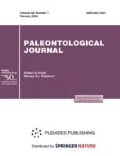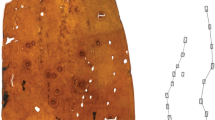Abstract
The paper deals with the stratigraphic range and morphology of fossil formations on plants interpreted as insect ovipositions. Our analysis of the insect fossil record has shown that the endophytic ovipositions probably belong to the Kennedyina and Triadophlebiina (in the Paleozoic and Lower Mesozoic) and to the Calopterygina (in the Upper Mesozoic and Cenozoic).
Similar content being viewed by others
References
O. Bethoux, J. Galtier, and A. Nel, “Earliest Evidence of Insect Endophytic Oviposition,” Palaios 19, 408–413 (2004).
N. N. Bogdanov-Kat’kov, Guidebook to Practical Training in General Entomology (Sel’khozgiz, Moscow, 1947) [in Russian].
L. Grauvogel-Stamm and K.-P. Kelber, “Plant-Insect Interactions and Coevolution during the Triassic in Western Europe,” Paleontol. Lombarda, Nov. Ser. 5, 5–23 (1996).
M. Helmund and W. Helmund, “Eiblageverhalten fossiler Kleinlibellen (Odonata, Zygoptera) aus dem Oberoligozän von Rott im Siebengebirge,” Stuttgarter Beitr. Naturk. Ser. B, No. 117, 1–17 (1991).
M. Helmund and W. Helmund, “Eilogen von Zygopteren (Insecta, Odonata, Coenagrionidae) in unteroligozänen Maarsedimenten von Hammerunterwiesenthal (Freistaat Sachsen),” Abh. St. Mus. Mineralog. Geol. Dresden 43/44, 281–292 (1998).
M. Hellmund and W. Hellmund, “Neufunde und Ergänzungen zur Fortpflanzungsbiologie fossiler Kleinlibellen (Insecta, Odonata, Zygoptera),” Stuttgarter Beitr. Naturk. Ser. B, No. 319, 1–26 (2002).
History of Insects, Ed. by A. P. Rasnitsyn and D. L. J. Quicke (Kluwer, Academic, Dodrecht, Boston, London, 2002).
J. Konijnenburg-van Cittert and S. Schmeißner, “Fossil Insect Eggs on Lower Jurassic Plant Remains from Bavaria (Germany),” Palaeogeogr., Palaeoclimatol., Palaeoecol. 152, 215–223 (1999).
A. N. Popova, Dragonfly Larvae of the Fauna of the USSR (Odonata): Identification Guide to the Fauna of the USSr, no. 50 (Akad. Nauk SSSR, Moscow, 1953) [in Russian].
L. N. Pritykina, “Paleontology and Evolution of Dragonflies,” in Fauna and Ecology of Dragonflies (Nauka, Novosibirsk, 1989), pp. 33–66 [in Russian].
D. V. Vasilenko, “Damages on Mesozoic Plants from the Transbaikalian Locality Chernovskie Kopi,” Paleontol. Zh., No. 6, 54–59 (2005) [Paleontol. J., 39 (6), 628–633 (2005)].
Author information
Authors and Affiliations
Corresponding author
Rights and permissions
About this article
Cite this article
Vasilenko, D.V., Rasnitsyn, A.P. Fossil ovipositions of dragonflies: Review and interpretation. Paleontol. J. 41, 1156–1161 (2007). https://doi.org/10.1134/S0031030107110147
Received:
Issue Date:
DOI: https://doi.org/10.1134/S0031030107110147




